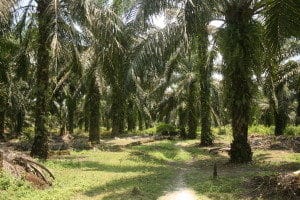On the Ground with Companies: Working Toward Sustainable Palm Oil
One of the many aspects of our work at Green Century includes engaging companies, policy makers, and non-governmental organizations (NGOs) to help bring about change; change that’s not only good for the environment and communities in which the companies we invest in operate, but also change that we believe minimizes the financial risks to investors associated with unsustainable practices.
As part of my trip, I’ve had the opportunity to meet with the Roundtable for Sustainable Palm Oil and some of the very companies we have worked with in the past and plan to work with in the future to ensure that palm oil is decoupled from poor land management practices.
Above: Palm trees on a sustainable palm oil plantation in Sumatra. Kate Kroll, Shareholder Advocate at Green Century, met with representatives from some of the largest palm oil companies to discuss sustainable sourcing practices.
Some of the companies here, which include Southeast Asia’s biggest agribusinesses, have demonstrated that there is significant progress happening on the ground. Companies like Wilmar,* as evident in the company’s most recent Sustainability Report, are listening to investor demand for sustainably sourced palm oil, and working to protect peatlands, increase traceability, and promote fire prevention mechanisms, a particularly timely topic given we are at the height of haze season.
Our, and other investors’ efforts have shown not only the risks avoided by implementing zero-deforestation policies, but also the opportunities gained; recent reports show that there are links between higher yields of fresh fruit batches and palm oil, when it is sourced sustainably.
In our eyes, it should be.
Investors are not the only stakeholders pressuring companies to move towards zero deforestation, geopolitical tensions are an influence as well. The disruption in economic activity due to last year’s haze crisis cost Indonesia $16 billion in losses according to the World Bank. As a result, Singapore has called for even more stringent haze prevention practices from its neighboring governments such as no palm expansion on peat.
Examples like the aforementioned show how these meetings have been beneficial and that we are clearly making progress, although there is much more work to do be done. I and other members of the Advisory Board are incredibly excited for what we’ve already accomplished, but also look forward to what comes next, and apparently, investors are as well.
To those of you who have been following this blog series, thank you. I hope you found it informative and motivating. For those of you who wish to read my previous posts, you can do so here. You can also learn more about Green Century’s work toward sustainable palm oil and how to take the first step in making an impact through the power of your investments.
Kate Kroll, Green Century’s shareholder advocate working on forest protection, is in Southeast Asia this month reporting on the results of Green Century’s forest protection work in transforming the palm oil supply chain. Sign up here to get updates sent right to your inbox.
*As of June 30, 2016, no securities mentioned were held in the portfolios of the Green Century Balanced Fund or the Green Century Equity Fund. References to specific securities, which will change due to the ongoing management of the Funds, should not be construed as a recommendation by the Funds, their administrator, or their distributor.
Stocks will fluctuate in response to factors that may affect a single company, industry, sector, or the market as a whole and may perform worse than the market. Bonds are subject to a variety of risks including interest rate, credit, and inflation risk. The Funds’ environmental criteria limit the investments available to the Funds compared to mutual funds that do not use environmental criteria.
You should carefully consider the Funds’ investment objectives, risks, charges and expenses before investing. To obtain a Prospectus that contains this and other information about the Funds, please click here for more information, email info@greencentury.com or call 1-800-93-GREEN. Please read the Prospectus carefully before investing.
This information has been prepared from sources believed to be reliable. The views expressed are as of the date of this writing and are those of the Advisor to the Funds.
The Green Century Funds are distributed by UMB Distribution Services, LLC, 235 W. Galena Street, Milwaukee, WI 53212. 9/16


